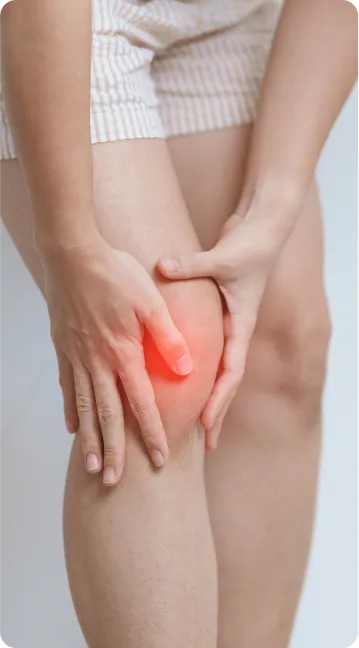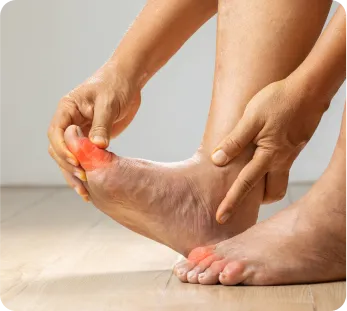Arthritis

MBChB (New Zealand), PGDipObstMedGyn, FRACP (New Zealand), FAMS (Rheumatology)
Beyond joint discomfort, arthritis can impact daily life by limiting movement and ability to perform routine activities as well as affecting sleep quality. Early diagnosis and personalised management can help control symptoms, slow disease progression, and protect long-term joint health.
Arthritis can cause joint pain, stiffness and inflammation. Although it can occur in people of all ages, some types of arthritis become more common with age. Common types of arthritis include:
The most common type of arthritis, caused by cartilage wear and tear. It often affects knees, hips, hands, or spine, leading to joint pain which worsens with activity, stiffness and gradual loss of flexibility and function.
An autoimmune condition where the immune system attacks the lining of the joint, causing pain, swelling, prolonged stiffness and tenderness, often in hands, wrists and feet. Without treatment, it can cause permanent joint damage and may affect other organs.
A painful arthritis caused by uric acid crystal build-up in joints. It commonly affects the big toe but can involve the ankles, knees, hands or elbows. Gout attacks usually happen suddenly, often at night, and cause redness, swelling, and intense pain in the affected joint.
Psoriatic arthritis occurs in some people with skin psoriasis. It is an autoimmune condition that affects the joints causing pain, stiffness and swelling. It can also affect the tendons and spine. The condition may also cause changes in the nails, such as pitting or separation of the nail from the nail bed.
AS is a chronic inflammatory arthritis that affects the spine and sacroiliac joints. It is an autoimmune condition that causes back pain and stiffness especially in the morning and after periods of inactivity. Over time, it may reduce flexibility in the spine if untreated. Inflammation may also occur in the other joints and other organs—most commonly, the eyes.

Conditions like rheumatoid arthritis or psoriatic arthritis occur when the immune system mistakenly attacks the joints.

Conditions such as gout happen when uric acid crystals build up in the joints, causing joint pain and swelling.

A family history of arthritis can make you more likely to develop it.

Arthritis can affect people of all ages, but the risk increases as we get older.

Certain bacterial or viral infections can trigger joint inflammation, sometimes leading to arthritis.

Past trauma or repetitive stress can cause long-term changes in the joints, even years later.

Smoking, poor diet, and lack of exercise may increase the risk of arthritis or worsen symptoms.



Early assessment can help prevent further joint damage and improve long-term outcomes.
You should see a rheumatologist if you notice:
Persistent joint pain, swelling, or stiffness, especially in the morning or after rest
Reduced range of motion in one or more joints
Warmth or redness around joints
Sudden, severe joint pain that may indicate a gout flare
Back pain that improves with movement but not with rest
Joint symptoms accompanied by skin or nail changes, or unexplained fatigue
These include blood tests to detect inflammation, autoimmune conditions or uric acid levels. In some cases, joint fluid may be collected to help confirm the diagnosis or rule out other conditions.
X-rays, ultrasound, computed tomography (CT) or magnetic resonance imaging (MRI) scans can show joint damage, cartilage loss, or crystal deposits. These tests help doctors assess the extent of arthritis and guide treatment decisions.
How Do Rheumatologists Treat Arthritis?
Rheumatologists specialise in diagnosing and managing arthritis and autoimmune conditions. Their care focuses on controlling inflammation, slowing disease progression, and protecting your joints for the long term. Treatment includes medications to address the underlying cause, supported by physiotherapy and lifestyle adjustments tailored to your needs. Surgery is only considered when other treatments are no longer effective. Dr Poh takes a thorough, personalised approach, considering your symptoms, lifestyle, and medical history to recommend the most suitable options.

Non-steroidal anti-inflammatory drugs (NSAIDs) and corticosteroids may be prescribed to ease discomfort, reduce swelling and improve mobility.

These medications help calm the overactive immune system, reduce inflammation, and protect joints from long-term damage. They are often the first-line treatment for autoimmune-related arthritis.

If DMARDs are not effective, biologic treatments may be recommended. These targeted medicines block specific parts of the immune system to better control inflammation and prevent joint damage.

In certain cases, targeted steroid injections can quickly reduce pain and swelling in affected joints.
Everyday habits play an important role in arthritis care. Maintaining a healthy weight, incorporating low-impact, joint-friendly exercises and avoiding repetitive strain can help reduce pain, improve mobility and support long-term joint health.
Guided exercises and techniques strengthen the muscles around joints, improve flexibility, and increase range of motion. This can make daily activities more manageable and improve overall quality of life.
Our Rheumatologist
Dr Poh Yih Jia
Senior Consultant Rheumatologist
Dr Poh Yih Jia is a dedicated rheumatologist with over 20 years of medical experience in New Zealand and Singapore. She has extensive expertise in diagnosing and managing a broad spectrum of arthritis conditions, ranging from common forms such as osteoarthritis and gout to complex autoimmune-related arthritis.

FAQs on Arthritis
There is no cure for most forms of arthritis, but treatment options can effectively manage symptoms, allowing you to continue enjoying your favourite activities.
While arthritis cannot be completely prevented, you can take steps to lower your risk and potentially delay its onset by:
- Maintaining a healthy weight
- Staying active with low-impact exercises
- Avoiding repetitive strain or high-impact joint stress
No. While osteoarthritis is more common with age, other forms of arthritis can affect younger adults and even children. Early diagnosis is important at any age.
Appropriate, low-impact activities like cycling or walking can help maintain joint flexibility and muscle strength. Exercise is especially important for people with arthritis to reduce pain and make moving easier.


